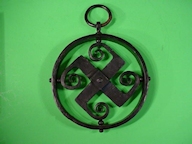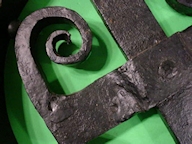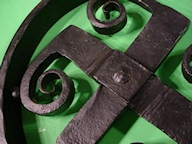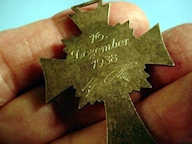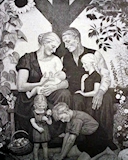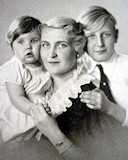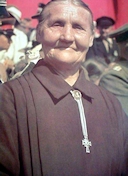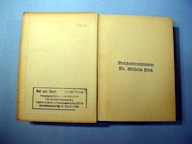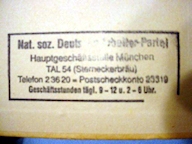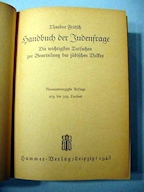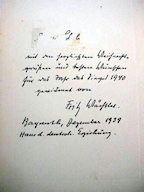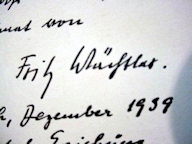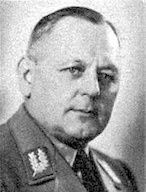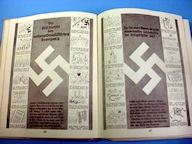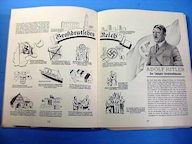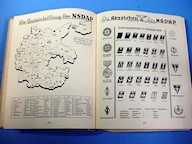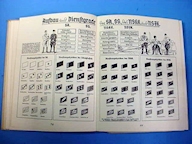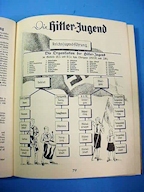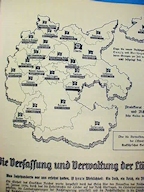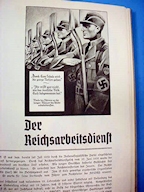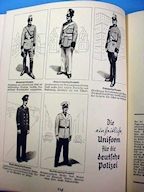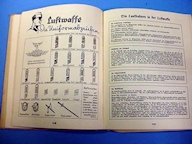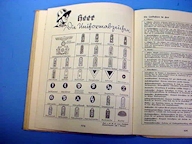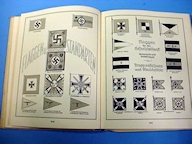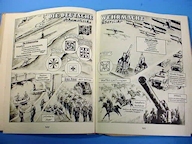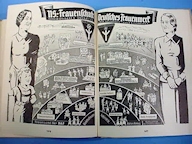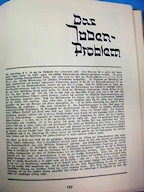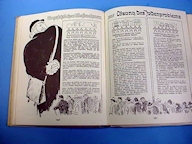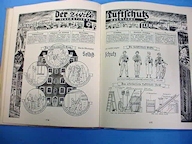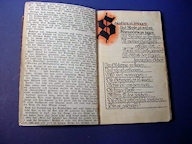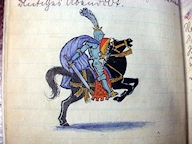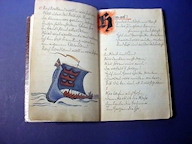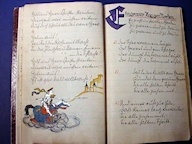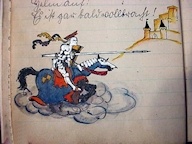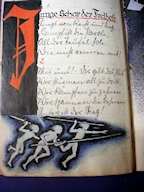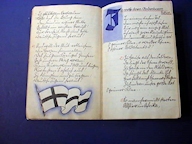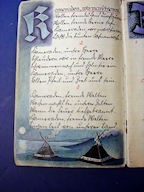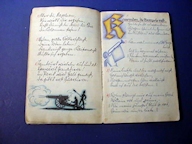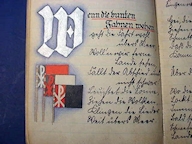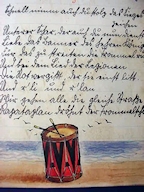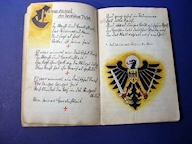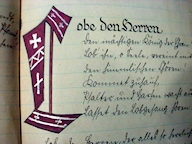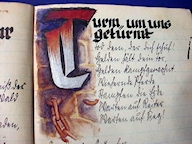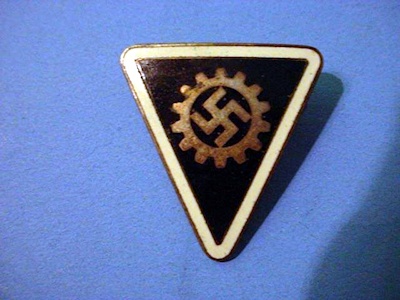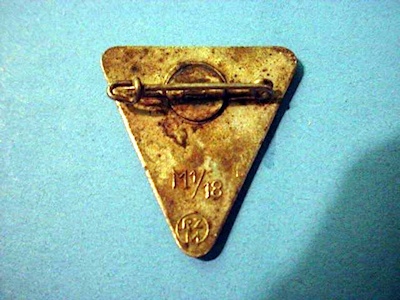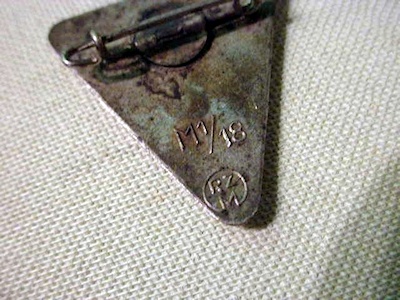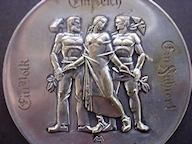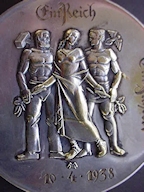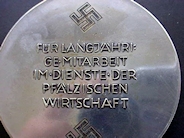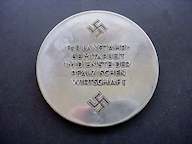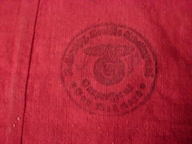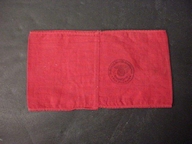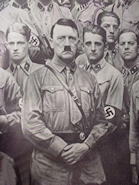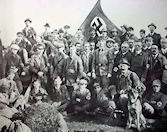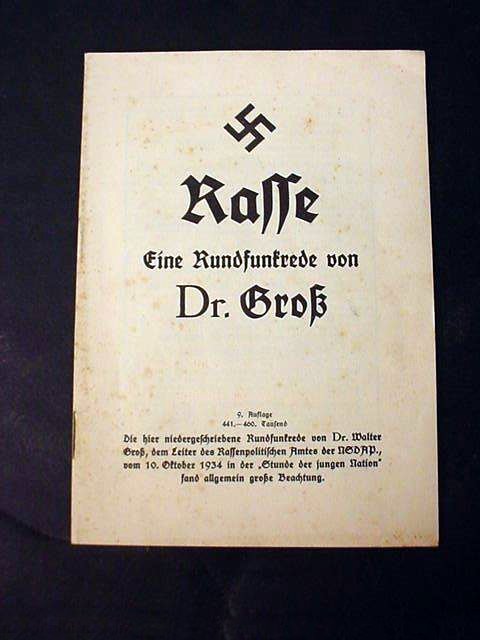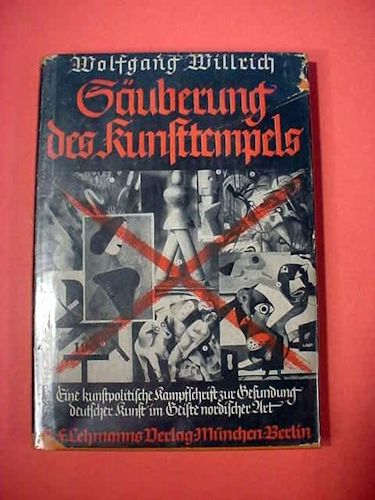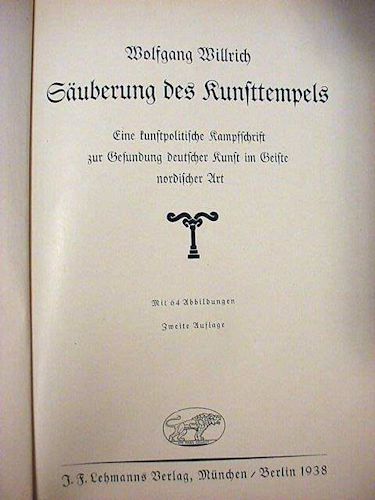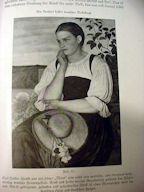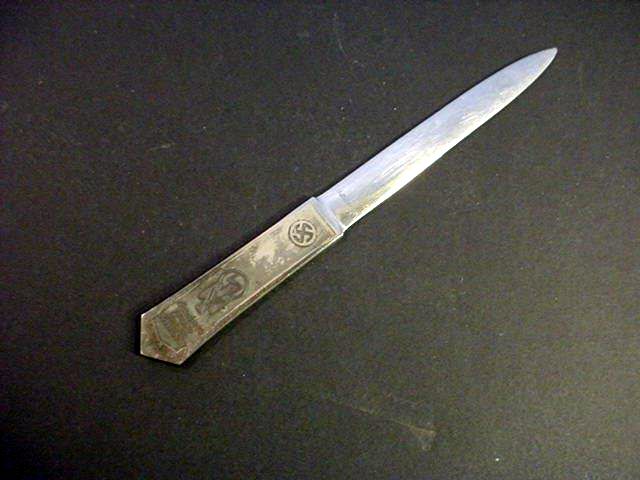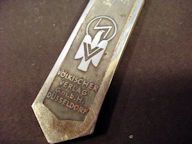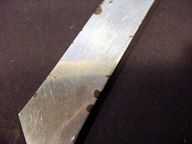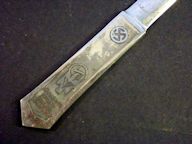|
[ Home Page ] [ Third Reich ] [
Old Reich ] [ Kaiser Reich ] [ Imperial Russia
] [ Axis Powers ] [ Italian Fascist ] [ WW
I ]
[ Landsknecht ] [ Kaiser Wilhelm ] [ Frederick the Great ]
N.S.D.A.P.
The Nazi Party
Page 20
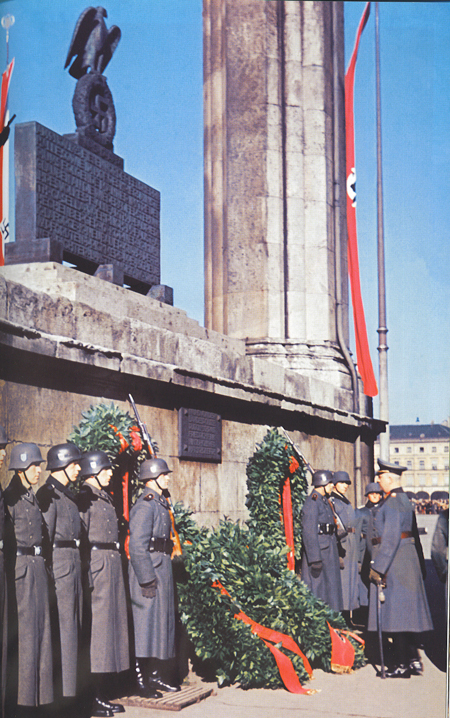
Ceremonies at the Feldherrenhalle
|

|
|
Iron Swastika (Item NSDAP 20-1; AHN 4-20)
|
DESCRIPTION: The Third Reich could be called the “Iron Reich.” Many items meaningful to
the Germanic Teutonic mythos were made of iron. This metal has been smelted from as far back as 1500 BC to the ancients. It was more important than
gold. It was from iron that weapons of warfare and hunting were forged. Later armor was fashioned from this metal. The discovery of it and its
applications became almost sacred to the ancient Germanic tribes and then to the Middle Ages when cannons ruled the field of war. Of the seven metals
known as the metals of antiquity, gold, silver, copper, and iron were king! These items, especially iron, were the metals that civilization was based
upon. Think about the words that have come out of the past concerning iron. Governments speak of iron rule! Bismarck was the Iron Chancelor,
Germany’s medal of valor was the Iron Cross. This was commonly called in ancient times “the warriors’ metal” and it was thought to be sent from and
ruled by Mars. Iron was and is used in rituals and amulets made of iron-promoted energy, strength, determination, willpower, assertiveness, and
aggression. We even advise that humans would eat of that which contains iron for maximum health. So this metal is still king. The National Socialists
were aware of this and they celebrated it in books, plays, art and, of course, architecture. The metal was venerated ceremoniously and the ancient
wisdom was celebrated in not only jewelry, but in symbolic décor that was seen on display all through the Reich. It was so used by the SS, the SA,
and in rituals of the NSDAP and especially by inner cultural groups such as the Deutsches Ahnenerbe Stiftung, where artistic configurations
such as the one we offer here were re-created from ancient themes. Often, farmsteads would have such a talisman hanging above their doors as a sign
of kinship and welcome. This particular piece is in the shape of a Hackenkreuz (swastika). We know that this symbol was used by dozens of
ancient culture groups worldwide, but here we are only interested in the Teutonic Germanic usage long before the adoption of the Hackenkreuz
by the National Socialists. It was used in the Germanic lands going back into the earliest times. To the peoples of classic antiquity it was a symbol
of eternal light from the sun and its arms represented the movement of the solar orb. It was often seen on the war shields of the Aryan tribes. In
the 20’s and 30’s the symbol was incorporated into the flag of Nazi Germany. The form of this swastika was called the Sonnenrad: the sun-wheel
Hackenkreuz. Unlike the stationary figure most used in the N.S. flags this depiction was mobile and perceived as moving. This one was said to
have been blacksmith made for the SS-Ahnenerbe (The foundation for historical research), Reichsführer Himmler’s favorite department of
the  organization. Many re-creations of ancient symbolism were
turned out by this academic study and exploration institute. These were a reminder of the glories of Germany’s colorful past. The piece is in solid
iron and measures 8 ½ inches in diameter and the smaller suspension ring is 3 inches in diameter. The piece is quite thick and heavy. This is a great
relic of the cultural Reich: “Kein Volk lebt länger als die Dokumente seiner Kultur!" organization. Many re-creations of ancient symbolism were
turned out by this academic study and exploration institute. These were a reminder of the glories of Germany’s colorful past. The piece is in solid
iron and measures 8 ½ inches in diameter and the smaller suspension ring is 3 inches in diameter. The piece is quite thick and heavy. This is a great
relic of the cultural Reich: “Kein Volk lebt länger als die Dokumente seiner Kultur!"
PRICE: SOLD
|
|
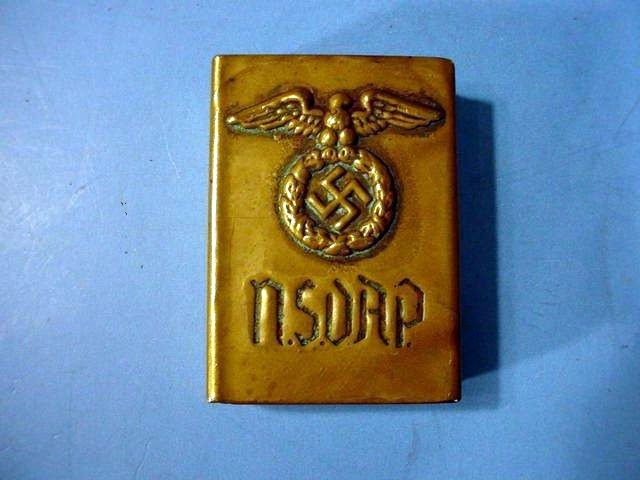
|
|
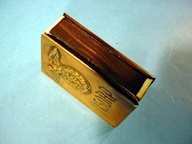
|

|
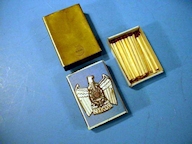
|

|
|
NSDAP Match Case (Item NSDAP 20-2)
|
| DESCRIPTION: Here is a neat little N.S. item. It’s a brass match safe for wooden matches and features the early National Socialist eagle. This is a “Kampfzeit” (early) depiction of the N. S. national emblem prior to 1933; also, it has “NSDAP” lettered on the front and was typically carried by SA troopers. Inside, there is a cardboard matchbox that has an image of an SA badge on one side and one of a veteran’s badge on the other. We don’t know if these images are original or were added by the former collector-owner, but, for sure the match case definitely is.
The abbreviation “GES. GESCH.” are seen on the backside; this means that the article was patented at the time.
< PRICE: SOLD
|
|
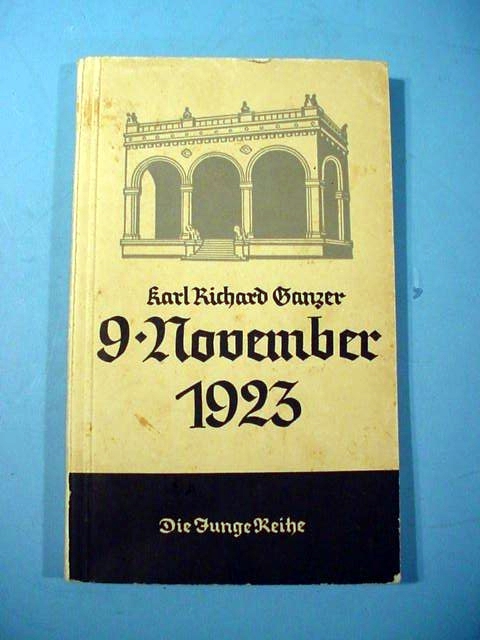
|
|
Booklet (Item NSDAP 20-3)
|
| DESCRIPTION: Here is an important booklet published in Germany in 1936 that chronicles the events that led up to and became the Putsch of 1923. It has a great cover that illustrates the Feldherrenhalle where the N.S. martyrs fell. It was published by Karl Richard Ganzer and contains 71 pages. It measures 7 x 4 ¼ inches. This is a great item to be placed alongside of that Blood Order in your collection.
PRICE: $150.00
|
|
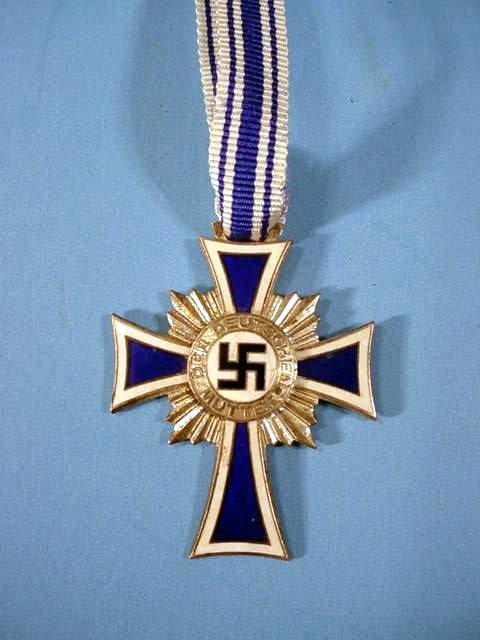
|
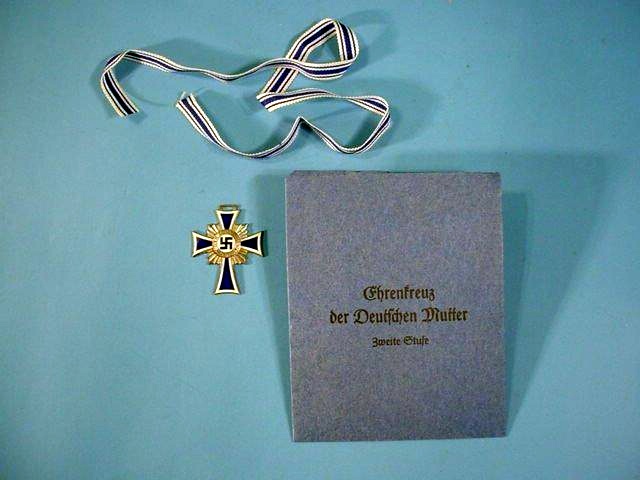
|
|
Deutsches Mutterkreuz N.S. Mother’s Cross with Issue Envelope (Second Class) (Item NSDAP 20-5; GEN 14-23)
|
DESCRIPTION: Here is the prettiest of all the German civil awards. It is probably the most common, but is still enthusiastically sought after by collectors. To find one with the original envelope of issue is certainly rare and a great collector’s find. The award was issued in three classes:
First Class in gold for eligible mothers with eight or more children
Second Class in silver for eligible mothers with six or seven children
Third Class for eligible mothers with four or five children
The decoration was conferred from 1939 until 1945 to Reichsdeutsche mothers who exhibited probity, exemplary motherhood, and conceived and raised at least four or five children in the role of a parent. The Ehrenkreuz der Deutschen Mutter was a state decoration and civil order of merit, one of the most respected awards of the Third German Reich. This one we offer is the silver Second [Level], (Zweite Stufe on package). It is in mint condition with the envelope of issue that is actually even rarer than the medal itself, believe it or not!
The German family it was procured from said the envelope was preserved in a cupboard right from the day issued in Vienna in 1940. The cross, though still in mint condition, was worn and the ribbon shows wear although still fine. This is very rare when with issue envelope.
PRICE: $350.00
|
|
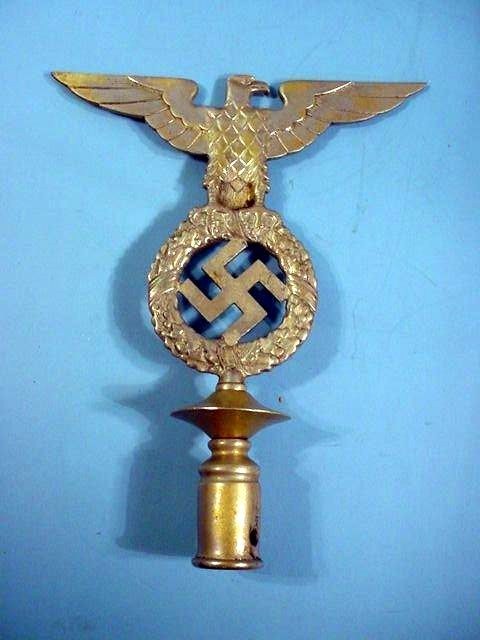
|
|
Early-Style NS Flagpole Top (Item NSDAP 20-6; SA 14-20; SS 36-10)
|
| DESCRIPTION: Here is a complete SA-SS flagpole top. To find one this complete is almost as hard to locate (and to some collectors, as desirable) as a Deutschland Erwache standard top. We have seen several of these with just the eagle and swastika portion with a threaded screw jutting out of the end and we have offered one or two of these in recent years, but this is the first complete one of these we have ever offered. When I say complete I mean with the barrel-shaped section with a saucer-shaped disc that the threaded screw goes into. The barrel is with the hole that the flagpole fits into and it has a hole in its side that takes a screw that holds the whole fixture firmly in place. The entire top is a little over 10 inches from the bottom of the barrel to the top of the head of the eagle. The wingspan is 8 inches. These flag finials were made of tough brass and are nickel plated. You can see a little bit of the brass showing here and there because this proud symbol was used in many of the parades in the Third Reich; both early SS and the SA Standarten used this style of eagle. It was also used by the political leader corps. This a rare and wonderful relic of the Reich.
PRICE: SOLD
|
|
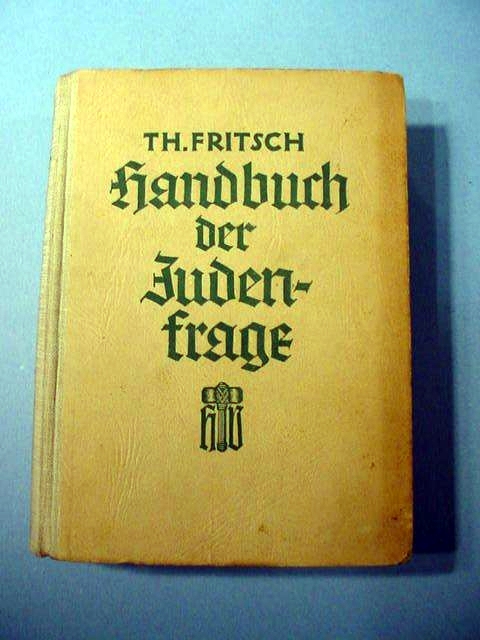
|
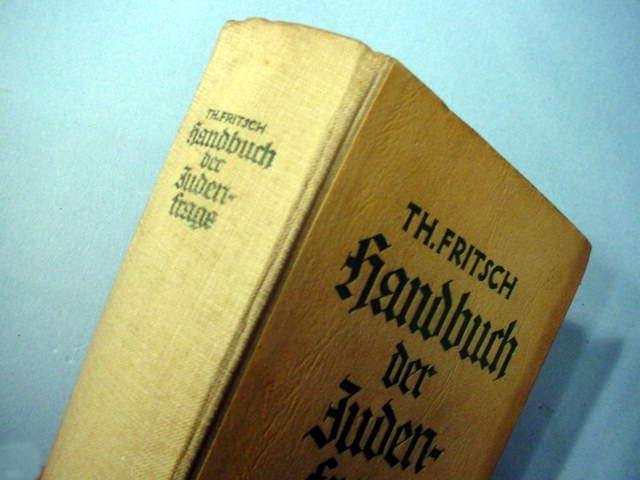
|
|
Book Handbuch der Judenfrage (Handbook on the Jewish Question) by Theodor Fritsch; from the NSDAP Collection of Reichsinnenminister Dr. Wilhelm Frick
(Item NSDAP 20-7)
|
|
DESCRIPTION: Theodor Emil Fritsch was one of the most influential figures of the new right that emerged after the unification of the German Reich in 1871. From the time of the Antisemitismusstreit in 1879, when the respected historian Heinrich von Treitschke caused a major debate amongst German academics when he used anti-Semitic stereotypes and declared “Die Juden sind unser Unglück! (Jews are our misfortune!),” through to the establishing of the NSDAP, Fritsch was active as an anti-Semitic politician, ideologue, and publisher, and was one of the leaders of the Völkisch movement. By his presence within the most important organizations of the German right, Fritsch provided the personal link between the early, “modern” anti-Semites of Imperial Germany such as Eugen Dühring and Wilhelm Marr, who inspired him in his early career, and the anti-Semitic movers of the German right in the Third Reich. By tirelessly promoting and spreading the ideology of “modern” anti-Semitism, Fritsch contributed to the “reshaping of the right” from the 1880s onwards and ensured that academic anti-Semitism became firmly anchored in the ideological make-up of the German right. Accordingly, there is rare agreement among historians of modern Germany about the importance of Fritsch for the development of right-wing extremism in Germany. As early as 1961, Reginald Phelps characterized Fritsch as “probably the most important German anti-Semite before Hitler.” Hans-Ulrich Wehler called him “a key figure of anti-Semitism and one of the ancestors of National Socialism.” More recently, Uwe Puschner described Fritsch as “the figurehead of racial and Völkisch anti-Semitism.” Despite this general agreement, however, only a few scholars have provided specialized studies of this crucial personality of the German right; an academic biography of Fritsch remains a desideratum.at best. In any case, this is a very rare book made much more scarce and desirable in that it was from the library of Dr. Wilhelm Frick, one of the most important interior ministers of the Third Reich. It could be said of him that the Third Reich would have never got off the ground were it not for his participation. Dr. Frick was a pivotal figure of great importance in Hitler’s Reich and as a result, he was tried at the star-chamber court at Nuremberg and was murdered there by hanging. Of course, this was managed by so-called “jurists,” who represented countries that had participated in much greater war crimes than they could lay at the door of Germany or its leaders in WW II. We will not chronicle the life and times of Dr. Frick here, and will leave that to your Google search, but as you look, bear in mind that the victors of any war write the history to include the history of the vanquished. The book has 573 pages and measures 7 by 5 inches and is 1½ inches thick. It is in excellent shape with partial cardboard-with-linen spine. It’s considered extremely rare.
PRICE: $225.00
|
|
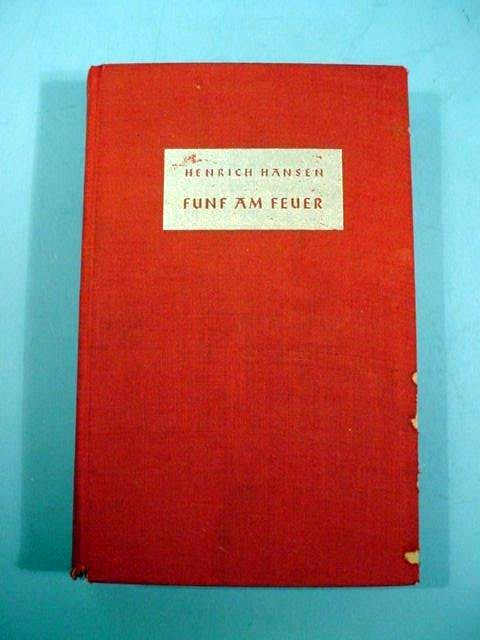
|
|
Book Signed by Fritz Wächtler, Gauleiter of the Bavarian Region of Gau Bayreuth (Item NSDAP 20-8)
|
DESCRIPTION: Wächtler, besides being Gaulieter, was also the head of the National Socialist Teachers’ League (NSLB). In 1935 and during World War II he held the honorary rank of SS-Obergruppenführer and Reichs Defense Commissar of Bayreuth. He replaced the very popular Hans Schemm, who was killed in an airplane crash. Schemm’s life was glorified by the NSDAP in the Third Reich and various schools, streets, and halls were named after him. Wächtler was not nearly as well liked, but he was an efficient administrator and astute politician. However, political intrigue managed to take him out in April of 1945. There is some controversy as to his actual demise so we have only the story spun by the war’s victors and the subservient Bundes government of present-day Germany.
The Book
Funf am Feuer by Henrich Hansen is a novel and was presented to someone, but we don’t who because the person obliterated his name out of the presentation probably fearing the dreaded denazification agents. In the flyleaf of the book Fritz Wächtler writes: “With my heartfelt Christmas greetings and my best wishes for the year of victory 1940. Dedicated by Fritz Wächtler. Bayreuth, December 1939 Home of German education.” And then he signs it.
A nice and important volume.
PRICE: SOLD
|
|
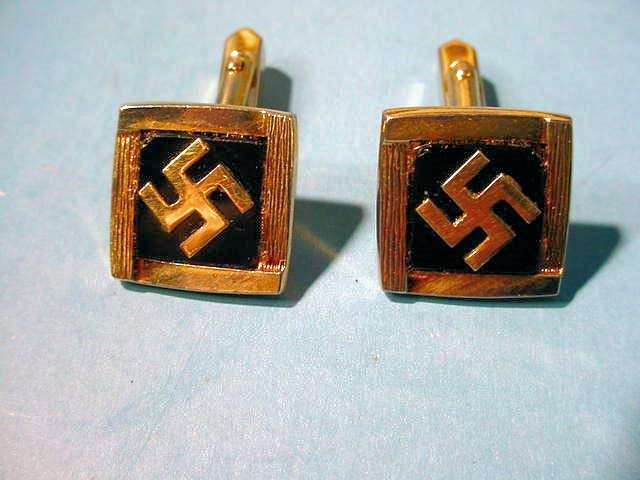
|

|
|
N.S. Political Leader’s Cufflinks (Item NSDAP 20-9)
|
|
DESCRIPTION: Here is a set of swastika cufflinks used by some of the higher political leaders of the NSDAP. They are in gold-plated brass with something like onyx or enameled centers with the swastika adhered separately to them. Standard European cufflink fittings (rarely seen), these will be perfect for you to wear to your next Reichsparteitag celebration or on the April 20, Geburtstag!
PRICE: SOLD
|
|

Note for size perspective the relationship to my arm |
|
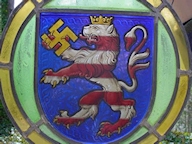
|
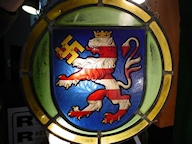
|
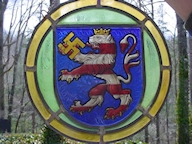
|
<

The modern Thüringen crest;
not nearly as brave as ours
| >
|

Gauleiter Fritz Wächtler
|
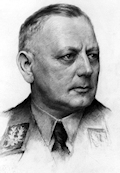
Gauleiter Fritz Wächtler; educator, NSDAP official
|
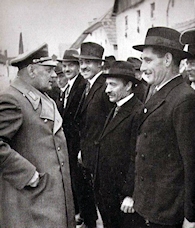
Wächtler with local teachers
|
|
Stained-Glass Thüringen Lion Window Hanging Having Belonged to NSDAP Gauleiter Fritz Wächtler (Item NSD 20-10; ART 17-16a; PERS 5-2)
|
DESCRIPTION: Stained-glass art goes back more than a thousand years. The name for this particular piece is Opalescent window art and actually it was originally an ancient art form from Munich and usually depicted religious themes. In Germany, a stained-glass window hanging as we offer here would be referred to as a Buntglas Fenster. Many years ago, Mr. Johnston, our historical advisor, lived in New York and was engaged for many years in the procurement and sales of war relics. He always had “the best”! There came a time that he approached a veteran or the vet approached him and told him that he had two ’Nazi’ stained-glass windows and was willing to sell them and several other items he had brought back (looted) from Germany. It turned out that from extrapolation of some letters and postcards that he said he took from the same estate that it was then loomed evident after subsequent research that here revealed was the Gauleiter of eastern Bavaria of Gau Bayreuth and that all the items were from his former office or home and that region. Wächtler also held the honorary rank of  -Obergruppenführer and Reich Defense Commissioner of Bayreuth. He had originally trained as a primary-school teacher and had the great honor bestowed upon him of being appointed the head of the Socialist Teachers League NSLB in 1935. He proved to be an able organizer and after the death of the first Gauleiter of the Bayreuth area, Hans Schemm, who died in an airplane crash, Wächtler was appointed his successor and until 1938 also served as the mayor of Bayreuth. -Obergruppenführer and Reich Defense Commissioner of Bayreuth. He had originally trained as a primary-school teacher and had the great honor bestowed upon him of being appointed the head of the Socialist Teachers League NSLB in 1935. He proved to be an able organizer and after the death of the first Gauleiter of the Bayreuth area, Hans Schemm, who died in an airplane crash, Wächtler was appointed his successor and until 1938 also served as the mayor of Bayreuth.
The glass window hanging
This magnificent piece of the glaser’s art depicts the arms of Thüringen. We wondered about this as Bayreuth was his official home and his workplace. Why Thüringen? Then it came to us! Wächtler was born in 1891, in Triebes Thüringen and it would have been understandably nostalgic to have this beautiful reminder of his ‘Heimat’ in his personal window. After joining the Nazi Party as member 35,313 in April 1926, he became its founding local group leader in his hometown of Triebes. He was elected as a member of the Bavarian Landtag and appointed deputy Gauleiter for the district of Thuringia. From August 1932, Wächtler served as education minister in the cabinet of the Minister President of Thüringen Fritz Saukel. Following the 1933 victory of the NSDAP until December 1935, Wächtler held the post of interior Minister of Thuringia and he also became a member of the Reichstag in Berlin. There is a controversy over his death. Some internet blogs say he was executed on the orders of Martin Bormann because he left the city of Bayreuth with his staff as American tanks approached. Bormann had ordered that all Gauleiters, Kreisleiters, and other NSDAP political leaders were to fight to the death in their districts. With the city in ruins and only 200 irregular defenders left, Wächtler left and set up offices in Waldmünchen in the southern part of the Gau. Some say he was executed by his own deputy, Ludwig Ruckdeschel, on orders from Bormann (Cause: desertion). Later evidence provides the more likely story that he was killed in an American bombing raid that followed. When Mr. Johnston bought this beautiful stained-glass window, hanging there actually was another one with it and that one was very impressive as well with the Coburg Honor Badge as its central design. This badge shows a Teutonic sword that has a background of a golden swastika and around its edges it says “Mit Hitler in Coburg 1922-1932” and at the bottom it says: “Presented by the Lord Mayor of the city of Coburg 1946 – Uberreicht vom Oberrugermeister der Stadt Coburg 1945” At the top of the badge partially covered by the grip of the sword is a depiction of the Coburg castle. This Thüringen window hanging is probably the prettiest piece we have ever offered and it speaks volumes about Germanic majesty and Third Reich history. The lion in the crest looks proud and ready for combat as he holds the Hakenkreuz (swastika) and he wears the crown of the old Thüringen kingdom. Compare him against the rather effeminate coat of arms of the modern Thüringen state and it’s probably fitting that that cowardly lion is surrounded by eight “Stars of David.” After the war, Thüringen officials in the former Third Reich administration were replaced by Communists, released criminals, sex offenders, and far-left goons in 1945, and the present administrators are the sons and daughters of these malfeasants. So, dear collectors, here is one of the finest relics of another civilization destroyed by the ‘Kulturträger’ (Bringers of culture)! Give it a proud home my Germanophile friends, it deserves it.
PRICE: SOLD
|
|
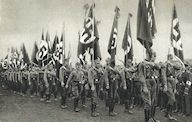
The brown battalions march against the Red terror.
|
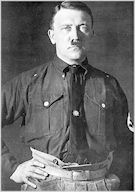
Adolf Hitler in 1922
|

NSDAP delegation in Coburg, 1922
|
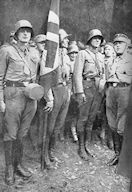
SA--Treue um Treue
|
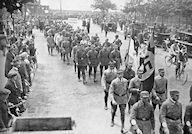
Vorwarts, Vorwarts, die Fahne Hoch!
|
|
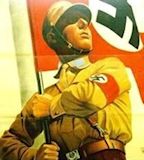
"Die Fahne Hoch!"
|
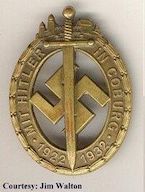
Actual badge the participants wore
|
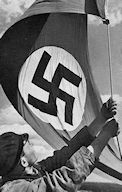
The swastika flag flies over Coburg.
|
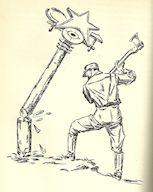
There came a change in old Coburg.
|
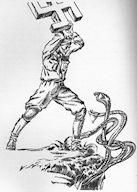
Sieg in Coburg
|
|
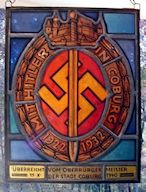
|
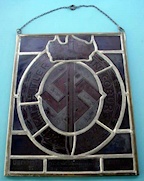
|

|
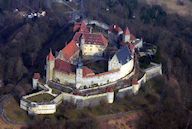
The Veste Coburg, one of Germany's largest castles
|
|

Saxon Gaulieter Martin Mutschmann wearing his Coburg badge
|

Julius Schreck, 1st commander of the SS wearing the Coburg badge
|

Jakob Grimminger, the bearer of the Blood Flag wearing the Coburg badge
|

Gauleiter Fritz Wächtler, right
|

Gauleiter Fritz Wächtler, center
|
|
Serious collectors, the famed Coburg Stained-Glass Window Hanging (Item NSD 20-11; ART 17-17; PERS 5-3)
|
DESCRIPTION: This is the other piece we mentioned in the article above chronicling the Thüringen Lion window hanging from the home or offices of Fritz Wachtler, Gauleiter of eastern Bavaria and Gau Bayreuth (please read the article above, for it relates this glass piece with that lion motif window hanging.) Mr. Johnston my, historical advisor, bought both the Thüringen Lion and the Coburg window hanging together in New York back some 40 years ago. After he sold them he was pretty sure he would never see them again. But, many years later it was brought to his attention that they ended up in the collection of Mr. William Blynn, a noted collector of only the finest and rarest of Third Reich art objects and historically important relics of that era. When Mr. Blynn passed away, all of his collection was turned over to a Connecticut auction house and to our amazement, the two glass items were among the pieces offered up for sale. Thankfully, this auction is little known to collectors of National Socialist items. The auction house’s specialty is signatures/autographs so I was able to procure the Thüringen piece in January 2013, and the Coburg badge piece in September. I paid dearly, but nowhere near the true value of these two wonderful items. There is some legal controversy between me and the auction house and litigation will soon commence (more on that in a separate article rating the auction firms). In the meantime, we believe we have secured two “Holy Grails” of N.S. relics. Hardly anything out there can match the desirability of these matchless treasures--especially the Coburg window. The Blutfahne might have more symbolic meaning and importance, but this piece runs a close second. Not many Third Reich antiques of the faith (N.S. Bewegung) can have more meaning than anything dealing with Coburg and the famous pitched battle that took place there in 1922 between the National Socialists and the Red Front. This is the place where the Nazi movement finally gained the final and full momentum to move assiduously toward the final Machtergreifung in 1933 (the ultimate seizure of power). Coburg was a town which had long been dominated by Marxists and other lowlife leftists, liberals, and their ilk, and it seemed strange that on a Saturday in October 1922, the town was to celebrate a Deutscher Tag (German Day) and even more oddly, Adolf Hitler was actually invited to attend—probably by a lone N.S. sympathizer on the town council. Hitler was asked to come and bring a” few friends”; however, we know that Hitler was an exceptional opportunist and he actually rented an entire train and filled it with 800 followers and even brought a great 42-piece band planning to take the town by storm. It must be remembered that in 1922 Hitler was a mere “nobody” and only his followers and Brown Shirt Storm Troopers thought that anything would come of him. According to public records and testimony of N.S. observers and marchers, the massed townspeople and wide-eyed Jews almost fell out of the express trains as they passed them. Hiring the train was accomplished by every N.S. member involved who bought one or more tickets often with his last Reichsmark. When the National Socialists arrived, a uniformed policeman and a town official told them that they could not march into the city with bands playing and flags flying and those words were music to the ears of Adolf Hitler. He actually pushed aside the policeman and the politician and the N.S. people marched into the town center with swastika flags flying and all the musical instruments blaring. Then it happened!. A crowd of thousands threatened to bar their way. Some of the crowd (fanatical communists) began to throw things (rocks and bottles) and a furious battle erupted lasting about 25 minutes, but in time most of the crowd began to join the Nazis and before long they had won over the towns people and the Reds were soundly bloodied and defeated. Here, at last, the citizens of Coburg and people across the nation envisioned a savior from the communist repression. However, the town officials were not exactly happy. The next day the Nazis triumphantly boarded the train and then Hitler was told that Red railroad-union members would not run the train back to Munich. Again, Hitler saw an opportunity. He told the railroad officials that he and his S.A. troopers would run the train themselves, but they would first kidnap every dirty communist they could find and take them back to Munich on the commandeered train. He made it clear that what would eventually happen to these Red thugs would be left to anyone’s imagination! The communists capitulated. The train ran. Hitler had won and in the minds of patriots at that time, Germany had won. In 1937, Hitler authorized and caused a badge to be struck to memorialize the event that might well be considered the turning point of National Socialism. They had progressed from failure to overnight discovery and immense popularity in the hearts and minds of the German populace. This highly esteemed award was equal in importance with the Blood Order. It was awarded only to the participants of the Coburg confrontation where the swastika won the day. The badge is highly sought after by collectors. It actually was a fairly simple-looking badge struck in bronze that shows the Coburg fortress at its top. This is the largest surviving medieval fortress in Germany famed for sheltering Martin Luther during the Diet of Augsburg. The oldest part of the castle (the blue tower) was built in 1230. In 1550, Martin Luther lived in the “Veste Coburg” for five and a half months. He stayed for the duration of the Diet of Augsburg, which he could not attend as he was considered an outlaw against the Holy Roman Empire much like Adolf Hitler was in the eyes of the postwar Weimar republic. Luther had worked on his German translation of the bible here and wrote no less than 22 works on reformation issues. So, you can see that the town of Coburg was important to at least two earth-shattering events. No wonder it was a much-coveted award to the March participants then and to collectors today and that is precisely why the bidding went high in the auction for this badge immortalized in stained glass. Thank goodness the auction house was not better known or the piece would have brought a price of ‘epic proportions.’ Many noted collectors knew of this piece for many years and will now be amazed that it is now available.
The Window hanging (Fenster Hängen)
The badge shown bears the legend ”MIT HITLER IN COBURG 1922-1932” and under the badge is seen in three panels the words ”ÜBERREICHT VOM OBERBÜRGERMEISTER DER STADT COBURG 15 x 1940.” The article shows that excellence of the art of Durchschientbilder. In no land is the art of stained-glass window hangings more practiced and perfected than in Germany. We have said that these pieces were from the home or office of Gauleiter Fritz Wachtler, who was also an  Gruppenführer. The translation of the words on the panels refer to the presentation of the panel by the Lord Mayor of the city of Coburg in 1940. The mayor of that grateful community wanted to present the highest and most prestigious gift imaginable to the Gaulieter. What do you give to a man who has everything? Well, give him what he doesn’t have! This undoubtedly was the greatest gift of all considering all the implications and spiritual mythos to the N.S. movement. We have offered the greatest and most historically important items in the past and present by far, and our customers say greater than any other militaria site, but we can readily say without any circumlocution that this may be the Zenith. Many other great relics actually fade in significance to this incredible and awe-inspiring relic of the Reich. It is without a doubt, magnificent, beautiful, and at the same time in a word “Overwhelming!”
By Paul Poole, General Manager, Germania International
Gruppenführer. The translation of the words on the panels refer to the presentation of the panel by the Lord Mayor of the city of Coburg in 1940. The mayor of that grateful community wanted to present the highest and most prestigious gift imaginable to the Gaulieter. What do you give to a man who has everything? Well, give him what he doesn’t have! This undoubtedly was the greatest gift of all considering all the implications and spiritual mythos to the N.S. movement. We have offered the greatest and most historically important items in the past and present by far, and our customers say greater than any other militaria site, but we can readily say without any circumlocution that this may be the Zenith. Many other great relics actually fade in significance to this incredible and awe-inspiring relic of the Reich. It is without a doubt, magnificent, beautiful, and at the same time in a word “Overwhelming!”
By Paul Poole, General Manager, Germania International
PRICE: $20,000.00
In the spring issue of Military Advisor, Vol. 25, Number 2, writer and historian Jeff Hanson wrote a brilliant 10-page article on the history of the event called: “At Coburg I made History.” These were the words of Adolf Hitler in remembering the famed victory of his party on October 14/15, 1922. On page 29 of the magazine article among some other historic Coburg items he shows a picture of the Coburg memorial window and claims 40 were created and presented to holders of the Coburg Badge on reaching their Silver Wedding Anniversary. We do know Fritz Wächtler received this one, but who else? If only 40 were given, only one has ever been found since the end of the war, and given the composition of the piece and the intense hate and vilification of the denazification officials after the Reich’s surrender it is doubtful that any other one will ever surface.
Below you will see one of the pages of that beautifully researched and presented article written by Mr. Hanson that appeared in the Military Advisor we referred to above. Here you can see the picture of the Coburg memorial window at the bottom right of the page. In the article there were pictures of Gaulieter Fritz Wächtler with Adolf Hitler. Wächtler was the man who was behind the promotion of the Coburg celebrations and the raising a memorial monument in the town of Coburg . He also was said to be the associate designer of the finished badge that was so prestigiously important in the Reich. The original Entwurf, or draft, for it however, was drawn up by Adolf Hitler, himself.
|
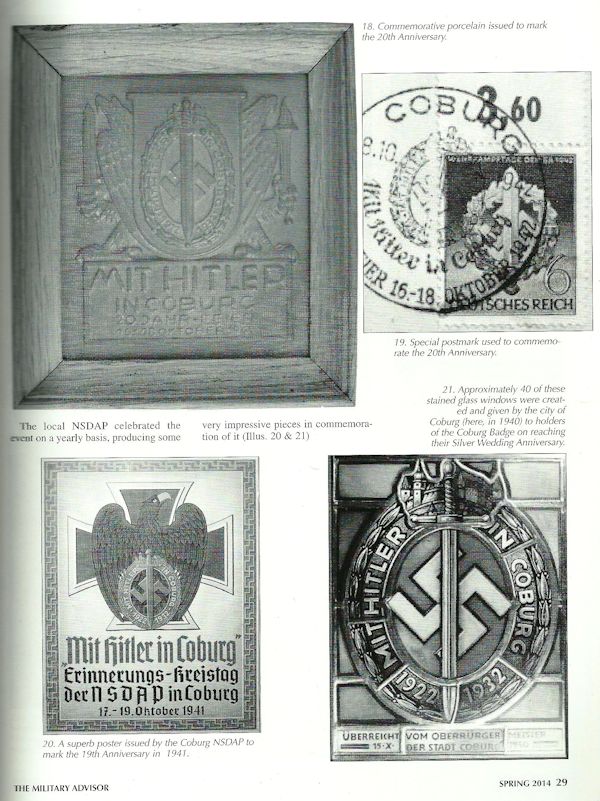
|

|
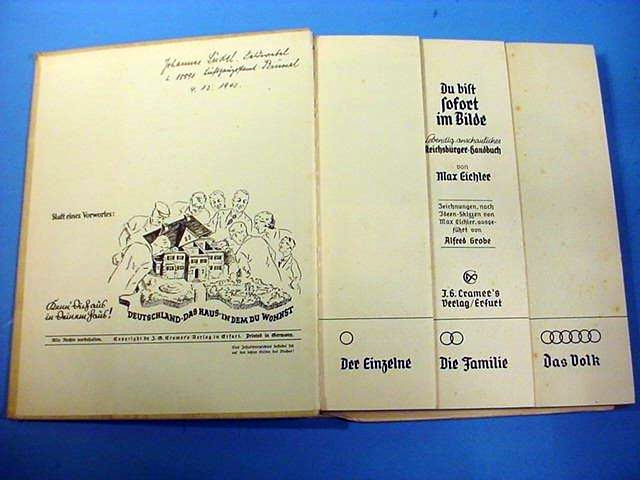
|
|
Book Du bist sofort im Bilde; You Are Now in the Picture (Item NSD 20-12; RAD 6-14; GEN 14-27; RAREBOOK 1-10)
|
DESCRIPTION: Here is a great linen-covered book that is a volume with 204 pages virtually loaded with the story of the history and the responsibility of the members of the NSDAP, schooling, and ideology, the program of the party, pages of the rank insignia of the political branches, SA, SS, NSKK, HJ, RAD, and beautiful chart showing the breakdown of the N.S. GAU system. Evident is the adoration of the Führer and his party, the story of the Wehrmacht, the oath of noble German soldiers, several pages glorifying the armed forces, several pages depicting the flags of the Reich both political and military, army ranks and insignia, air force and navy, and three pages on the Luftschutz and the police. Architecture, labor, promotion of respect for labor are included and there are several pages depicting Germany’s industrial progress, handworkers’ items, and three pages on the Jewish problem, farming issues, cultural pursuits, schooling, women, and motherhood, the Four-Year Plan, sports(?), and colonial properties. All of this priceless information is portrayed in great illustrations. This has to be the greatest book ever printed that illustrates all the great social and cultural issues that made the Third Reich possibly the finest-formed government ever designed for the betterment of the lot of true Germans (but then it tragically ended!) and now we envision and experience the NEW WORLD ORDER. Are we better off?
PRICE: SOLD
|
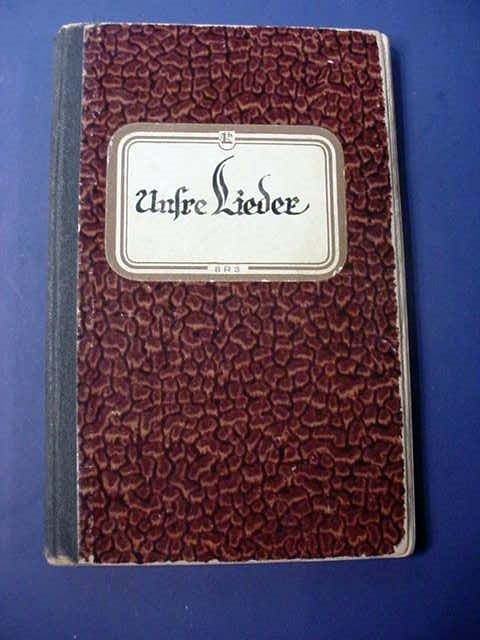
|

|
|
Hand-written, Hand-illustrated Songbook Unsre Lieder (Our Songs) (Item NSD 20-13; RAREBOOK 1-11; YOUTH 9-17)
|
DESCRIPTION: Here is what I would have to call a national treasure. It is a small 6½ x 4-inch-sized book with heavy cardboard covers. It is titled Unsre Lieder (Our Songs). It is made up entirely of many pages of nationalistic songs many of them written for the Hitler Youth and it was a loyal member of this organization who put this marvelous book together. It was a labor of love for this lad as you can see through the obviously enthusiastic rendering by his own hand of the beautiful artwork; it shows his absolute love of his German Fatherland. The writing is in German script of the old school (the romantic letters of beauty). There are illustrations of knights, witches, banners of Prussia, a Viking dragon ship, the magnificent Prussian eagle, cannon fire, a bugle boy, and camp scenes with Indian-type tepees, among others. This is evidence of the noble interests and education of this nonliberal, diversity-lacking culture age that was so different from the acid age of today where the dregs of the jaded society worship such degenerate and despicable punks that present themselves as knights of Satan (KISS), the Rolling Stones, and other vicious forms of expression. Frank Sinatra said: “Rock and Roll is a most brutal, ugly, desperate, vicious form of expression it has been my misfortune to hear.” Germany, the land of Beethoven, Wagner, and Brahms, is now to some extent the land of totally degenerate music as is our America, the nation that infected Europe beginning after WWII. As the dangerous march to perdition goes on at least we know that the author of this little songbook was not under the spell of Lucifer.
PRICE: $175.00
|
|
|
|
N.S. Woman’s Organizational Insignia–Arbeitsmaiden of the Deutsche Frauenwerk (Item NSD 20-14; PINS 8-19; RAD 6-15)
|
| DESCRIPTION: National Socialist women who were actually active in the political life of the nation were organized into the Nationalsozialistische Frauenschaft abbreviated NS-Frauenschaft and the Deutsche Frauenwerk (DFW), the German Women’s Welfare Organization. The compulsory political labor service of German girls was organized and performed in the Reichsarbeitsdienst (RAD). In peacetime women were normally given only the traditional duties of Kinder, Küche, Kirch–children, kitchen, church—as often expressed by Kaiser Wilhelm in earlier times. However, once the German men marched off to war the women had to replace them on the farms and in the factories and that was when the Arbeitsmaiden idea became so crucial. This insignia worn by these ladies employs the usual upside-down triangle of the Frauenschaft but with the cogged wheel of the Deutsche Arbeitsfront (DAF). It is much scarcer today than the normal Frauenschaft pin. This example has the “RZM” mark on the back with its item identification code of “M1/18.” It measures 1¼ inches high and 1 inch wide. It’s in excellent condition.
PRICE: SOLD
|

|

|
|
Cased Award for Long Service and Assistance in the Service to Properties in the Pfalz (Item NSD 20-15)
|
DESCRIPTION: Here is a large, silver-plated nonportable award that was given to exemplary workers in the section of the Fatherland known as the Pfalz. This is a narrow stretch of land that extends peacefully through a gentle landscape of budding vineyards. The Pfalz is the center of the German wine country the medal has two male figures with a female at their center. The males show implements representing labor and education, while the lady holds sprigs of vegetation in each hand undoubtedly representing the wine growing and merchandising in the region. Around the four sides of the round medal are the words and date: “Ein Volk, Ein Reich, Ein Führer“ and the date “10/4/1938.” On that date the new Reichstag met under the chancellorship of Adolf Hitler both in Germany and Austria asking the populace whether they approved of the single list of members of the NSDAP for the 813-member Reichstag as well as the annexation of Austria. The back of the medal has two swastikas top and bottom and the words: “Für Langjährige mitarbeit im Dienste der Pfälzischen Wirtschaft.” This means: “For many years working in the service of the Palatine economy.” Economy refers to a wine-land property manager probably associated with National Socialist public works for the betterment of the Phalz area—a very important position in the N.S. Four Year Plan. This is a very beautiful and meaningful cased medal.
PRICE: $375.00
|
|
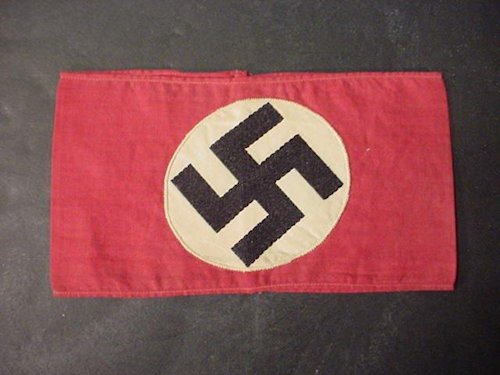
|
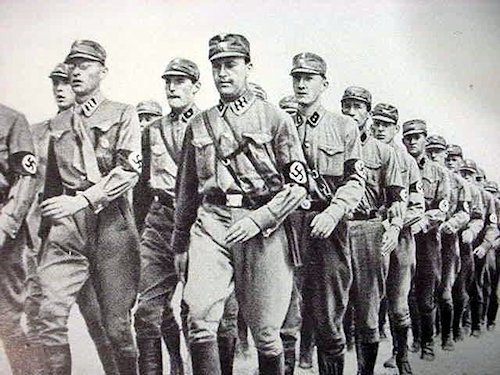
|
|
Party Press Armband with Gau Stamp in Germany (Item NSD 20-16; SA 14-23)
|
|
DESCRIPTION: This is a nice original NSDAP armband of the style issued to the Storm Troops (SA). It has the red, cotton field with white circular field and the machine-embroidered swastika. What sets it apart is the Gau press stamp on the back. It is the early Kampfzeit N.S. eagle and the words translate to “The National Socialist German Workers’ Party.” Here is the bonus: it says GAU Presse-Amt--“The Press Office.” So the man who wore this was obviously a party reporter who would cover events like the annual Party Congress at Nuremberg. Under this is the section he belonged to: GAU WESTMARK.
PRICE: SOLD
|
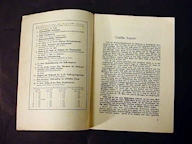
|
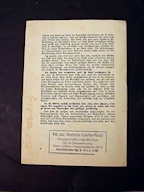
|
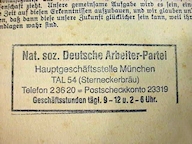
See the NSDAP-property stamp
|
|
Booklet Rasse: A Speech by Dr. Gross (Item NSD 20-17)
|
|
DESCRIPTION: This was a speech on racial hygienics delivered
October 10, 1934, as part of a series of speeches by various eugenics professors and theoreticians at the event named Stunde der junge Nation (Time of the Young Nation). Dr. Gross was a leader of the racial political offices of the NSDAP. The booklet comprises eight pages of his important historical speech and it bears the official stamp of the NSDAP head office in Munich. This is a significant find in prodigiously important historic archival material concerning racial hygienic laws.
PRICE: $60.00
|
|
| 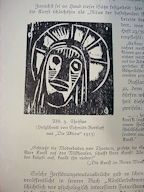
Their conception of our Christ
|
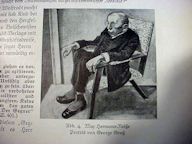
|
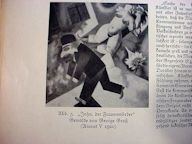
Murder
|

Self-portrait of modern artists???
|
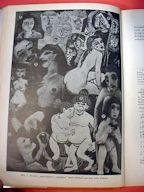
|
| 
|
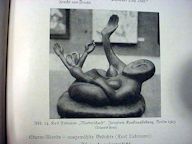
Motherhood
|
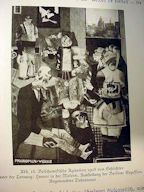
|
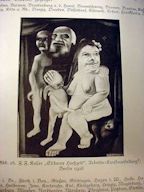
Silver wedding anniversary
|
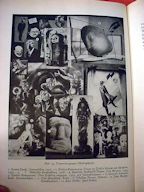
|
| 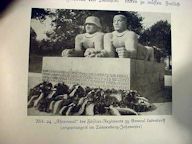
War memorial; German soldiers depicted as rodents
|

|
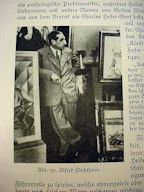
|

|
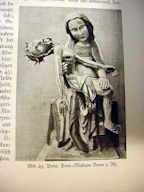
Their depiction of the "Passion"
|
| 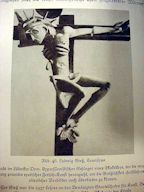
Cricifix
|

True sacred art of Germany
|
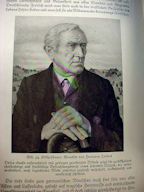
Wolfgang Willrich's depiction of an elderly man
|

Art as it should be
|
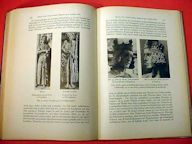
Art of the West
|
|
|
Book Säuberung des Kunsttempels (Purging the Temples of Art) by Wolfgang Willrich.
The German subtitle translates to: “A Political Art Fighting Trieste on the Cleaning Up of German Art in the Spirit of Nordic Art”
(Item NSD 20-18; RAREBOOK 2-4; ART 17-24)
|
DESCRIPTION: STOP! . . . and hopefully reflect on the findings of the N.S. association for the preservation of Aryan culture. What follows is its description and explanation of what constitutes degeneracy in art. This is one of the rarest and most-sought-after books ever published in the Third Reich. Produced in the year 1937 (a banner year for the Third Reich), there was at that time an exhibition in Berlin known as Die Ausstellung “Entartete Kunst” translated as The Degenerate-Art Exhibition. It was actually organized by Adolf Ziegler and the “Party” (The National Socialist German Workers’ Party) and ran from July 19 to November 30, 1937. The exhibit presented 650 so-called “works of art” from German museums and was presented in counterpoint and contrast to the current great German art exhibition. The day before the exhibition started, Hitler delivered a speech declaring merciless war against cultural disintegration by attacking chatterboxes, dilettantes, and art swindlers. Degenerate art was defined as works that insult traditional German mores and cultural tradition or destroy or confuse natural form, or simply reveal a complete absence of adequate manual and artistic skill. One million people attended the exhibition in its first six weeks. A U.S. critic commented, “There are plenty of people, true art lovers in Boston and throughout the U.S., who will stand with and absolutely side with Hitler in this particular purge.” Hitler had a passionate critique of modern art and its practitioners. He (and this author) perceived them to be incompetents, cheats, and madmen! A commission was formed with Adolf Ziegler as its chairman and toured various art museums in several cities seizing 5,238 so-called art pieces that they deemed degenerate showing qualities such as decadence, weakness of character, mental disease, and racial impunity. The commission especially focused on works by ‘artists’ mentioned in avant-garde publications and was aided by some vehement steady opponents of modern art such as the famed art master of the realistic art form, Wolfgang Willrich. Many of the lowest and horrid canvases by such dubious luminaries such as Georg Kolbe, Paul Klee, Marc Chagril, and (“UGH!”) Pablo Picasso abound. About 20,000 persons per day attended the exhibition. On the walls accompanying the oil and watercolor trash were signs proclaiming sentiments and slogans, for example:
*Insolent mockery of the divine (and Christian)
*Revelation of the Jewish racial soul
*Insult to German womanhood
*The ideal–Cretin and Whore
*Deliberate sabotage of national defense
*German farmers–a Yiddish view
*Madness becomes method
*Nature as seen by sick minds
*Even bigwigs dared to call this trash the art of the German people.
All in all, the idea was well carried that modernism was a conspiracy by those who would harm German decency. After the exhibition closed in 1937, the REAL artist, Wolfgang Willrich, put together the volume we now offer. It is basically a summation of the Entartete Kunst exhibition with running commentary from this man who is possibly the greatest artist in realism that Germany had seen since Albrecht Durer. Willrich had published several books that graphically portray the nobility and beauty of the Aryan race and Germans in particular. His illustrations are so vivid, so real, as to be practically spiritual in the physiognomy displayed. No Nordic person who is conscious of his beginnings can look upon Willrich’s painting of Germanic peasant folk, the children, the aged, the soldiers, sailors, airmen, and  elite troops without a special pride swelling up in the breast. And of course alternatively the traditional enemy experiences the same emotion that the vampire experiences when suddenly confronted by a crucifix! No art critic or historian could have been better chosen to do a review of the exhibition from the standpoint of critique. Here was Herr Willrich the man considered the shining light of beautiful renderings of humanity looking at the dark side of art, the stuff straight from Hell! The book contains about 170 pages with 64 illustrations. You will notice the Irminsul in the center of the opening title page indicating that this might have been an Ahnenerbe publication and it was published by the J. Lehmanns Verlag in Berlin 1938. This company published several Ahnenerbe-certified books in the 1930s. The book is in fine condition with original dustcover preserved by the former collector who covered it with plastic. Its size is 6 ½ x 9 inches and I assure you it is a very highly sought-after volume throughout Europe, especially in Germany and Austria where a revisionist awakening appears to be taking hold. It is one of the absolutely rarest N.S. books extant today. In 50 years, I have not seen another available. The price is most reasonable considering its content and its extreme rarity. elite troops without a special pride swelling up in the breast. And of course alternatively the traditional enemy experiences the same emotion that the vampire experiences when suddenly confronted by a crucifix! No art critic or historian could have been better chosen to do a review of the exhibition from the standpoint of critique. Here was Herr Willrich the man considered the shining light of beautiful renderings of humanity looking at the dark side of art, the stuff straight from Hell! The book contains about 170 pages with 64 illustrations. You will notice the Irminsul in the center of the opening title page indicating that this might have been an Ahnenerbe publication and it was published by the J. Lehmanns Verlag in Berlin 1938. This company published several Ahnenerbe-certified books in the 1930s. The book is in fine condition with original dustcover preserved by the former collector who covered it with plastic. Its size is 6 ½ x 9 inches and I assure you it is a very highly sought-after volume throughout Europe, especially in Germany and Austria where a revisionist awakening appears to be taking hold. It is one of the absolutely rarest N.S. books extant today. In 50 years, I have not seen another available. The price is most reasonable considering its content and its extreme rarity.
PRICE: $700.00; At this point in time it is probably unique!
|
|
|
|
National Socialist Letter Opener (Item NSD 20-19; GEN 14-29)
|
| DESCRIPTION: Here is a really neat-looking period letter opener. It is 9 ½ inches long and features a Sonnenrad Hakenkreuz (sun-wheel swastika). Below this is a stylized eagle that looks like the Teutonic fibula figuration seen in so many books of the Third Reich dealing with ancient Germanic culture. In the eagle’s chest you see the configuration of a double "V" and behind the head is a runic symbol similar to the one used by the Hitler Youth and the SS. Below this it says “Völkischer Verlag G.m.b.H. Düsseldorf.” Obviously, this was a print shop or newspaper that had official National Socialist support and sympathies. It is constructed in steel and is in very good condition except for some slight rust spots on the back of the grip. It sort of looks to me like something that would be presented to the head office of a place like the “Brown House” in Munich as a promotion that might sell printing supplies or services to the NSDAP or its many facets within the inner structure of the party. It’s quite dramatic looking and surely a great addition to any N.S.D.A.P. collection or even a complete edged-weapon grouping.
PRICE: $475.00
|
Contact Us
Please refer to item designator in parentheses in all correspondence.
Please E-mail for any additional information you may need.
If you prefer, contact 'Germania' at PO Box 68, Lakemont, GA 30552
or call at 706.782.1668 or 706.782.4398.
Please! do not call during the wee hours of the morning. The best time for calling us is between 10 am and 12 noon and between 9 and 11 pm
eastern time.
|
| | | | |

 organization. Many re-creations of ancient symbolism were
turned out by this academic study and exploration institute. These were a reminder of the glories of Germany’s colorful past. The piece is in solid
iron and measures 8 ½ inches in diameter and the smaller suspension ring is 3 inches in diameter. The piece is quite thick and heavy. This is a great
relic of the cultural Reich: “Kein Volk lebt länger als die Dokumente seiner Kultur!"
organization. Many re-creations of ancient symbolism were
turned out by this academic study and exploration institute. These were a reminder of the glories of Germany’s colorful past. The piece is in solid
iron and measures 8 ½ inches in diameter and the smaller suspension ring is 3 inches in diameter. The piece is quite thick and heavy. This is a great
relic of the cultural Reich: “Kein Volk lebt länger als die Dokumente seiner Kultur!"



